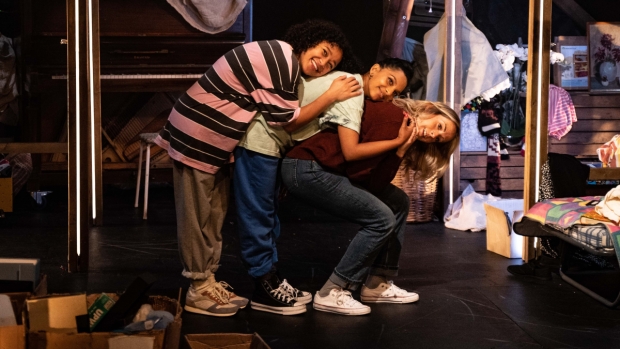”Blood Harmony” at Traverse Theatre – Edinburgh Fringe review

In Thickskin’s new play with music, Blood Harmony, three sisters hunt through their recently deceased mothers’ possessions, while unboxing and unpacking their relationships with her, each other, and themselves. In less capable hands, this might be too cliché to bear – but, with a gorgeous soundtrack of music by folk trio The Staves as the foundation on which the show is built, it’s instead a beautiful and moving exploration of grief and love.
Blood Harmony‘s success rests on two factors – a dramaturgical appreciation of what the music can do, and a cast of expertly sketched characters. The sisters – overachieving and distant Anna, free-spirited and freewheeling Maia, and responsible baby of the family Chloe – as well as their mother, the aching gap they all circle around, all make perfect sense. Each event in Matthew Bulgo’s script strikes the balance between inevitability, that of course this combination of personalities will hurt and love each other in this particular way, and predictability, that even when a plot point might seem obvious, it is well-earned. Much of the credit for this must also go to performers Eve de Leon Allen, Keshini Misha and Philippa Hogg, who bring the sisters to life and are equally convincing in love and anger.
The role of music in the show, then, is what makes Blood Harmony particularly special. Each element of the direction and design work outwards from the songs, and from the emotional knots that the characters are able to express when singing. Rather than trying to make the music part of the real world of the funeral, the grief and the conversations around it, directing/choreography team Jonnie Riordan and Jessie Williams have the sisters break and burst through the attic into song and into a more abstract space, where they can climb up the roof, sit amongst the stars, and walk through walls. Sound designer Neil Bettles and musical director/arranger Kate Marlais deserve particular credit here, for the different storytelling qualities that the songs can take on, able to in turn fill the theatre like a cavernous church, or move through time in the snow.
Much of this is made possible through the show’s brilliant design. The house, which the girls’ mother was so determined to fill, in Hayley Grindle’s careful and intelligent design becomes simultaneously a playground, a stairway to the stars, and an empty frame waiting for Maia, Anna and Leah to fill. Grindle is willing to take advantage of negative space and the height available in Traverse 1, which really allows Charly Dunford’s lighting to (forgive the pun) shine. As well as having the scaffolding on the house light up in neon, Dunford also has it cast great shadows throughout the space, allowing the attic and its contents to loom as large for the audience as it clearly does for the characters.
Ultimately, Blood Harmony works best because of this – an understanding of where its own strengths lie, and a dedication to ensuring that its audiences will understand and empathise with the same. A gorgeous 90 minutes, well worth taking time from your Fringe to see.










